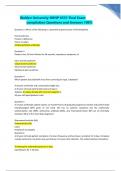Exam (elaborations)
Walden University NRNP 6531 Final Exam compilation Questions and Answers 100% Question 2. Which of the following is a potential acquired cause of thrombophilia Homocystinuria Protein C deficiency Factor V Leiden Antiphospholipid antibodies Question 3
- Course
- Institution
Walden University NRNP 6531 Final Exam compilation Questions and Answers 100% Question 2. Which of the following is a potential acquired cause of thrombophilia Homocystinuria Protein C deficiency Factor V Leiden Antiphospholipid antibodies Question 3 Phalen's test, 90°wrist flexion f...
[Show more]



